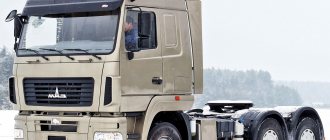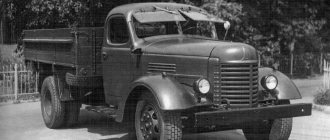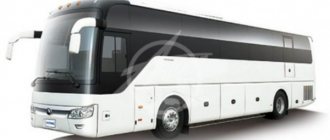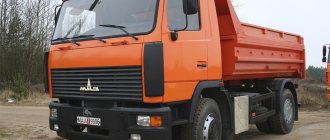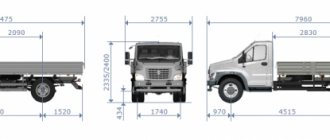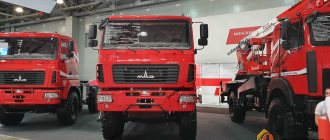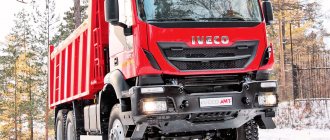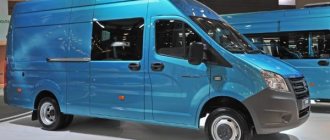Historical facts
As many people know, YaMZ series engines are installed on cars and buses of the Minsk Automobile Plant. The history of engine installation begins in wartime, when pavilions for the assembly of heavy equipment for the Wehrmacht were organized in Minsk. And already in 1944, according to a decree of the USSR government, construction of the plant began. In parallel with this, Minsk begins production of GMC and Studebaker cars.
With the support of the Yaroslavl plant in 1947, the first five domestic MAZ-205 trucks rolled off the assembly line of the Minsk plant. By and large, the MAZ-205 is a modified version of the YaAZ-205 truck, which was manufactured in Yaroslavl. From that moment on, almost all MAZ vehicles began to be equipped with engines supplied by the Yaroslavl plant.
Credit of trust
One of the bonuses for those who purchased a truck with a Weichai engine, strange as it may sound, is the interest in promising engines on the part of MAZ itself. Representatives of the plant try to track the operation of each vehicle with the “heart of a dragon”, sending surveys to carriers to establish clear feedback. Moreover, there are two questionnaires: one for the driver, one for the mechanic. And each one has the right questions, taking into account the nuances of perception from different sides: from the cockpit or from the viewing hole.
I was allowed to take a sneak peek at the survey results, with the condition that I not disclose details. In fact, for once, Minsk residents are simply playing it safe – the reviews were mostly positive. Operators note the good traction properties of the engines, low noise levels from the Weichai engine and low fuel consumption. Moreover, some have already expressed a desire to replenish their MAZ fleet with Chinese engines.
However, it should be taken into account that we are talking about MAZ-643029, MAZ-544029 truck tractors and MAZ-650129 dump trucks with Euro 4 engines, which are no longer installed on equipment coming off the assembly line. But there are no reviews on the current Euro 5 yet, so make allowances for everything that was said earlier.
The only drawback voiced by carriers is the poor preparation of local service departments for the arrival of a new engine. The result is longer service times and the need for pre-registration. At MAZ they are aware of this problem and are now actively retraining service station specialists to work with Weichai engines. In addition, during the period of adaptation to new power plants, it is practiced to create mobile teams with diagnostic instruments in order to eliminate identified deficiencies at the carrier’s base, saving his time. The approach is modern, let's see how it works in real life.
The lineup
At the end of the 50s, the YaAZ engines were replaced by the legendary YaMZ 236 and YaMZ 238, which were equipped with MAZ trucks until recently. The engines were distinguished by quite high power, and at the same time were easy to maintain and repair. The Mazovsky power unit was also supplied to other trucks, such as KrAZ and K-700 series tractors.
Later, Mercedes engines began to be installed on MAZ cars. But then it was decided to refuse, since engine repairs were quite expensive, and the price of vehicles had increased significantly. The plant management decided to leave the Mercedes engines for installation on the bus line.
Moreover, since 2011, YaMZ began to supply a new line of modernized power units of the 530 series, which included YaMZ-534 and YaMZ-536. At the same time, Yaroslavl refused to produce an 8-cylinder engine, and instead began producing a 4-cylinder with a smaller volume
Motors of the Celestial Empire
The Weichai Power company, whose products the Minsk Automobile Plant has turned its attention to, needs no introduction. These motors are well known in Russia with all their pros and cons. Some people praise them, some criticize them, but the overall picture is that they are a good modern engine if it is maintained as it should be. By the way, there seem to be no issues with the service either - Weichai is simple and repairable.
The line that MAZ currently installs on its trucks consists of three families.
The first is WP7. Two 7.5-liter engines, WP7.270E51 and WP7.300E51 with 271 and 299 hp. Accordingly, they are installed on trucks for regional transportation, as well as on various chassis for municipal vehicles.
The promising WP7.270E61 and WP7.300E61 also belong to this family. A special feature of these engines is their compliance with Euro 6 environmental standards. A reasonable foundation for the future.
The WP10 family is a 375-horsepower 9.7-liter in-line six WP10.375E53, relevant for the Kolos family: dump trucks, truck cranes, etc. technique.
The flagship family in the current model range is the WP12. It is the WP12.430E50 motor that is designed for installation on equipment from the Prostor family. Displacement – 11,596 cm3, power – 430 hp, torque – 2060 Nm.
On all engines, the achievement of Euro 5 is due to the use of urea, so tanks with a blue cap will now become an integral part of MAZ vehicles. This choice is quite understandable - the thermal stress, and therefore the service life of an engine with an SCR system is significantly higher than with EGR technology. And bench tests of the two technologies showed noticeable efficiency of the engine with the SCR system.
The 280-horsepower WP10NG280E51 deserves special mention. This is still the same in-line “six” of the WP10 family, only designed to run on natural gas (methane). It is this that Minsk residents, along with Cummins and YaMZ, are currently actively testing as part of developments on gas issues.
In addition, active work is underway on the “compact” WP4 family. It will be represented by an inline four WP4.1NQ190E50 of Euro 5 environmental class. The 190-horsepower engine with a displacement of 4100 cm3 is perfect for the Cornet family of medium-duty vehicles. Taking into account the growing demand for equipment with a gross weight of up to 12,000 kg, this is, as they say, “a bast in a row.”
In principle, until recently MAZ also offered the WP12.430E40 engine of the Euro 4 environmental class, but with the advent of Euro 5 in Russia, it was considered unpromising, and has now been replaced by the aforementioned analogue WP12.430E50.
Technical characteristics of Weichai engines
| Model | WP12.430E50 | WP10.375E53 | WP7.300E51 | WP7.270E51 | WP7.270E61 | WP4.1NQ190E50 | WP10NG280E51 |
| Type | Diesel, I-6 | Diesel, I-4 | Gas, I-6 | ||||
| Working volume, cm3 | 11 596 | 9726 | 7470 | 7470 | 9470 | 4100 | 9726 |
| Power, hp | 430 at 1900 min-1 | 375 at 1900 min-1 | 299 at 2100 min-1 | 271 at 2100 min-1 | 270 at 2100 min-1 | 190 at 2600 min-1 | 280 at 1900 min-1 |
| Maximum torque, N∙m | 2060 at 1000–1400 min-1 | 1650 at 1200–1500 min-1 | 1250 at 1200–1700 min-1 | 1250 at 1200–1400 min-1 | 1160 at 1200–1700 min-1 | 680 at 1300–1900 min-1 | 1150 at 1200–1500 min-1 |
Engine repair
Repair of the MAZ engine, especially the YaMZ-236/238 series, is quite typical for diesel and turbodiesel engines. Of course, it is recommended that such operations be carried out by professionals at a truck repair service center. This is due to the fact that special equipment is required to repair the block and head.
To repair the injection pump, you will need special knowledge and skills, as well as special tools, which not every driver has in his cab. As for the crankshaft, it can withstand up to three repairs, and then, as practice shows, it has to be replaced.
Drivers can change parts themselves, such as a water pump, oil filter, engine oil, fuel filter element, etc., without any problems.
MAZ-6317
0
Source:
MAZ-6317 was a three-axle, all-wheel drive truck equipped with an eight-cylinder YaMZ-8424 turbodiesel with a power of 420 hp. The engine was paired with a 9-speed manual transmission YaMZ-202. The single-stage transfer case and front axle (with the original gearbox) were borrowed from the MAZ-5434, and the rear axles were shared by the MAZ-64221. In general, the MAZ-6317 was quite widely unified with already produced vehicles. In addition to the components described above, the truck received a comfortable cabin from the MAZ-6422 highway truck and a riveted frame unified with it in the profile of the side members.
×
How to distinguish a new YaMZ engine from one that has undergone a major overhaul
- home
- Engines
- How to distinguish a new YaMZ engine from one that has undergone a major overhaul
We guarantee the factory origin of the engines presented on the site!
The easiest way to distinguish a new factory YaMZ engine from a repair one (a YaMZ engine after a major overhaul) is by the block number.
In the engine block number (also known as the engine number), the first digit is the year of manufacture; in 2022 it looks like K0ХХХХХХ, in 2022 it looks like J0ХХХХХХ. There cannot be new engines with other numbers!
Previously released engines:
- H0хххххх - engines manufactured in 2022
- G0хххххх — engines produced in 2016
- F0хххххх - engines produced in 2015
- E0хххххх - engines produced in 2014
- D0хххххх - engines produced in 2013
- C0хххххх — engines produced in 2012
- B0хххххх — engines produced in 2011
- A0хххххх — engines produced in 2010
- Fully digital numbering - engines produced before 2010
The block number on six and eight-cylinder engines is stamped on a special ebb. The ebb is located in the flywheel area, on the left under the intake manifold. On counterfeit engines, the ebb with the block number is often painted over or sanded down. A metal plate (nameplate) is attached to the camber of the cylinder block in the area of the fan drive.
The ebb for the block number on twelve-cylinder engines is located in the flywheel area, on the right under the intake manifold. On counterfeit engines, the ebb with the block number is often painted over or sanded down. A metal plate (nameplate) is attached under the left intake manifold, opposite the ebb with the block number.
What are individually assembled (service) YaMZ engines? How to check the originality of a YaMZ engine
The block number is duplicated on the nameplate with the YaMZ engine marking (nameplate). An example is the YaMZ-650 engine (the plate is installed on the cylinder block on the left side in its middle part).
Information on the plate: 1. Trademark of JSC Avtodizel (YaMZ) Yaroslavl Motor Plant. 2. Mark of conformity with the national standard and code of the authority that issued the certificate. 3. Mark of compliance with the requirements of the Special Technical Regulations. 4. YaMZ engine model and its equipment. 5. The year when the YaMZ engine was produced, indicated by the last digit of the year of manufacture, where 9 is 2009. YaMZ engines of 2010 are designated by the letter A. 6. Serial number of the YaMZ engine.
The year of manufacture and engine number of the YaMZ 650 are duplicated on a plate attached to the block on the right side in its middle part.
The designation of the electronic control unit on the YaMZ engine and its number are indicated on a plate attached to the control unit housing.
The model of the high pressure fuel pump (HPFP) of the YaMZ engine and its number are indicated on the plate attached to the fuel pump housing.
The designation of the turbocharger and its serial number are indicated on a plate attached to the compressor housing of the YaMZ engine.
Particular attention should be paid to the issue of factory origin if you are purchasing an engine for agricultural purposes - these engines are not subject to registration with the State Traffic Inspectorate and their unscrupulous suppliers most often pass off repair ones as new ones.
If you are offered an engine and its origin is in doubt, do not be lazy to request a photocopy of the engine passport and you can check whether the engine left production with the same number and fuel injection pump number by calling the Yaroslavl Motor Plant directly. And not only the engine, but the engine of this particular modification, since a regular YaMZ 238 M2 engine can be “transformed,” for example, into a YaMZ 238 AK engine with its own modifications, because the difference in their cost is quite large.
If, even after checking the numbers of the YaMZ engine and the high-pressure fuel pump, doubts remain, contact the traffic police to check whether the number has been changed at a special site, because Recently, cases of duplication of numbers of new engines produced by the Yaroslavl Motor Plant for old engines that have undergone repairs have become more frequent.
Final advice - choose your suppliers more carefully and you will be spared problems during the subsequent operation of YaMZ engines!
Decoding the markings of MAZ trucks
In this article we will consider the topic: “ Deciphering the markings of MAZ trucks .”
Before purchasing, it is useful to know what each digit of the MAZ modification marking means, and today maz-diler.ru will tell you about this in detail:
For example: MAZ 6430E8-530-020
1. The first number 6 - indicates the load capacity from 20.0 to 40.0 (can be seen in the table below)
| Gross weight, t | Types of MAZ cars | |||||
| Onboard | Tractors | Dump trucks | Tanks | Vans | Special | |
| up to 1.2 | 13 | 14 | 15 | 16 | 17 | 19 |
| 1.2 to 2.0 | 23 | 24 | 25 | 26 | 27 | 29 |
| 2.0 to 8.0 | 33 | 34 | 35 | 36 | 37 | 39 |
| 8.0 to 14.0 | 43 | 44 | 45 | 46 | 47 | 49 |
| 14.0 to 20.0 | 53 | 54 | 55 | 56 | 57 | 59 |
| 20.0 to 40.0 | 63 | 64 | 65 | 66 | 67 | 69 |
| over 40.0 | 73 | 74 | 75 | 76 | 77 | 79 |
2) The 2nd digit means the type of truck:
3 — pickup truck or flatbed cargo vehicle; 4 — truck tractor; 5 — MAZ dump truck; 6 - tank; 7 - van; 8 - reserve digit; 9 - special car.
3) 3 and 4 digits are a serial number, that is, for us it is 30
4) Next comes the designation of the level of environmental standard, in our example it is E,
5) The letter is followed by a number that indicates the engine power in horsepower:
Mercedes-Benz engines are slightly different and here the designation is as follows: perhaps there would be the letter “B”, but it is replaced by the numbers “18” (for Euro-3) and “19” (for Euro-4)
6) digit 5 is a modification of the car;
7) 6th digit - indicates the performance... that is, for what conditions the truck is intended:
1 - for cold climates; 6 — export version for temperate climates; 7 - export version for tropical climates.
the following numbers are separated by a dash
5 - cab model 30 - gearbox model
9) then through the dash 020 - this is the type of suspension
By the way, you can see all the MAZ chassis models that are used to complete various modified assemblies of the plant's cars.
TRANSSERVICE is the official dealer of MAZ OJSC in the Far East and the official dealer in the Khabarovsk Territory
Source
Engine speed is not adjustable - MAZ
We were lucky with new applications. The first brigade had to go to a MAZ request with a non-working gas pedal. Diagnostics determined that the engine harness is faulty. The Belarusian craftsmen at the plant were too lazy to throw a harness of a special shortened size on the car for short tractors and installed a harness from a long one, tying the excess one with a figure eight to the engine and leaving it to dangle almost on the floor. When opening the harness, a break and short circuit were discovered. Moreover, the latter appeared from melted snow and the accumulation of water in the corrugation of the tourniquet. Without thinking for a long time, we fix it. The owner, a former photojournalist, was surprised at the skill and speed of the work. The work was paid for and the owner was satisfied.
